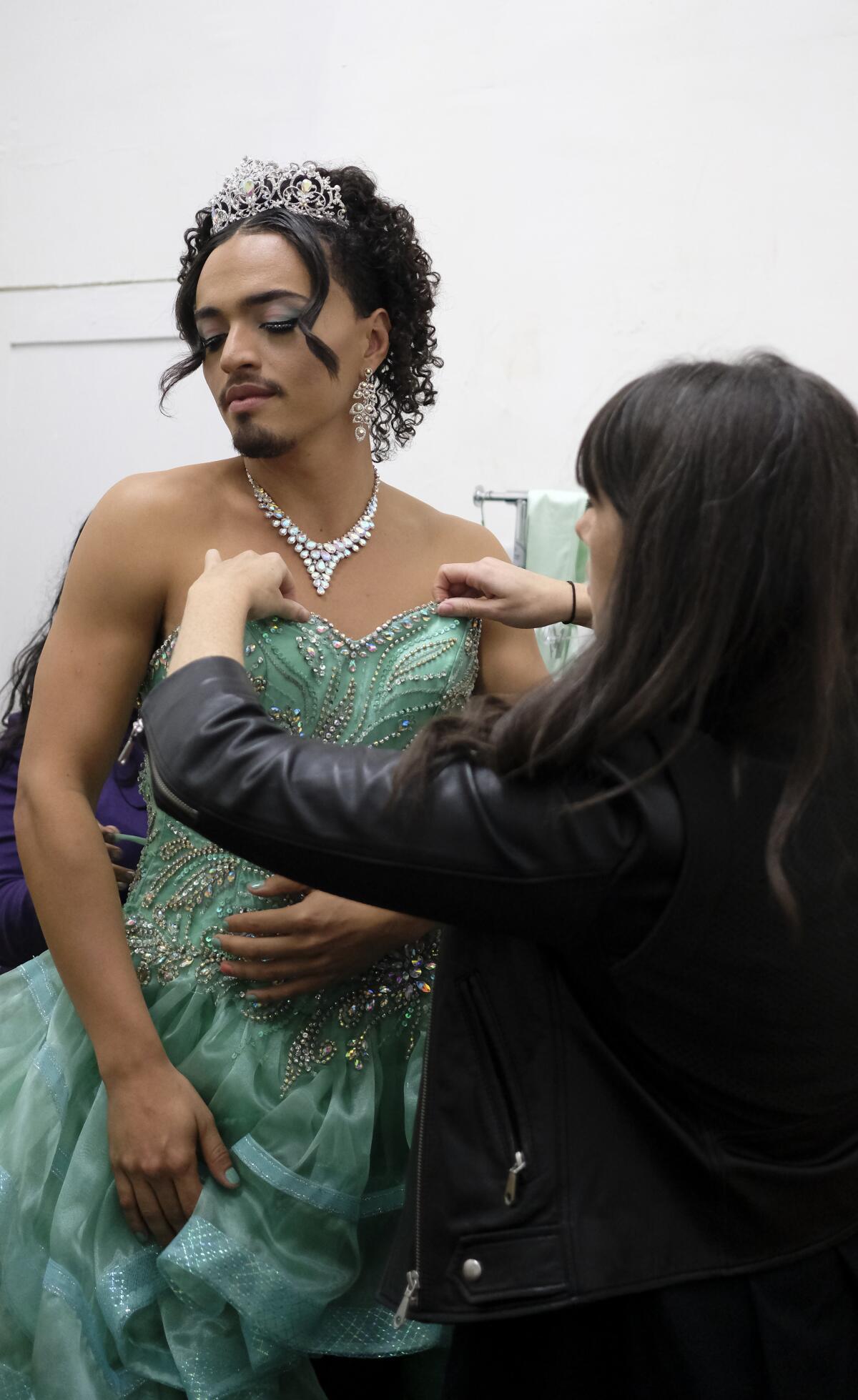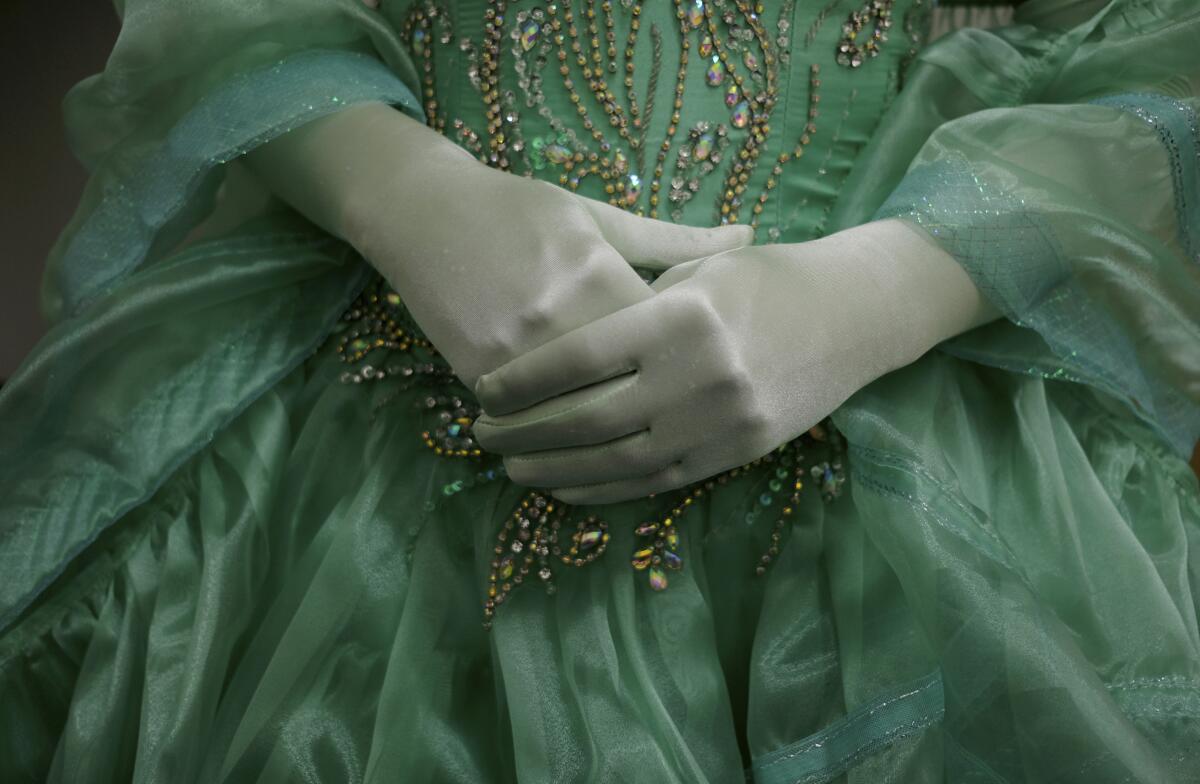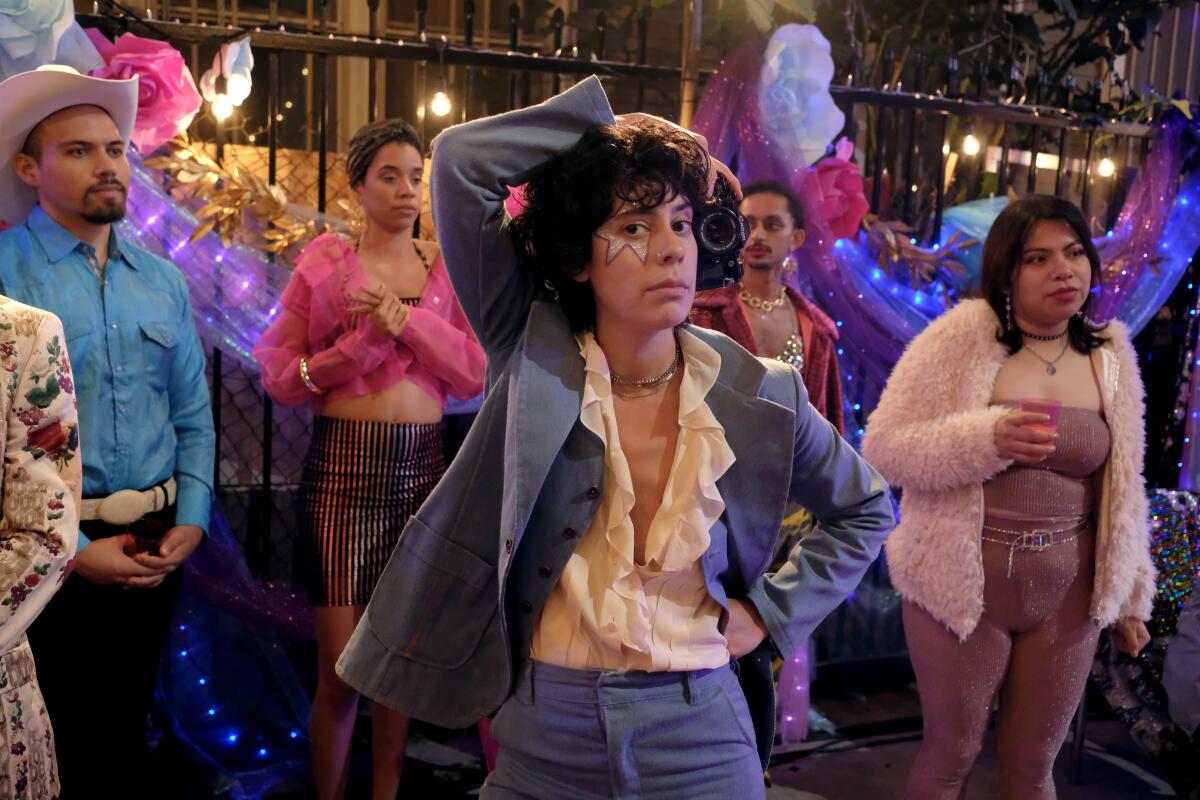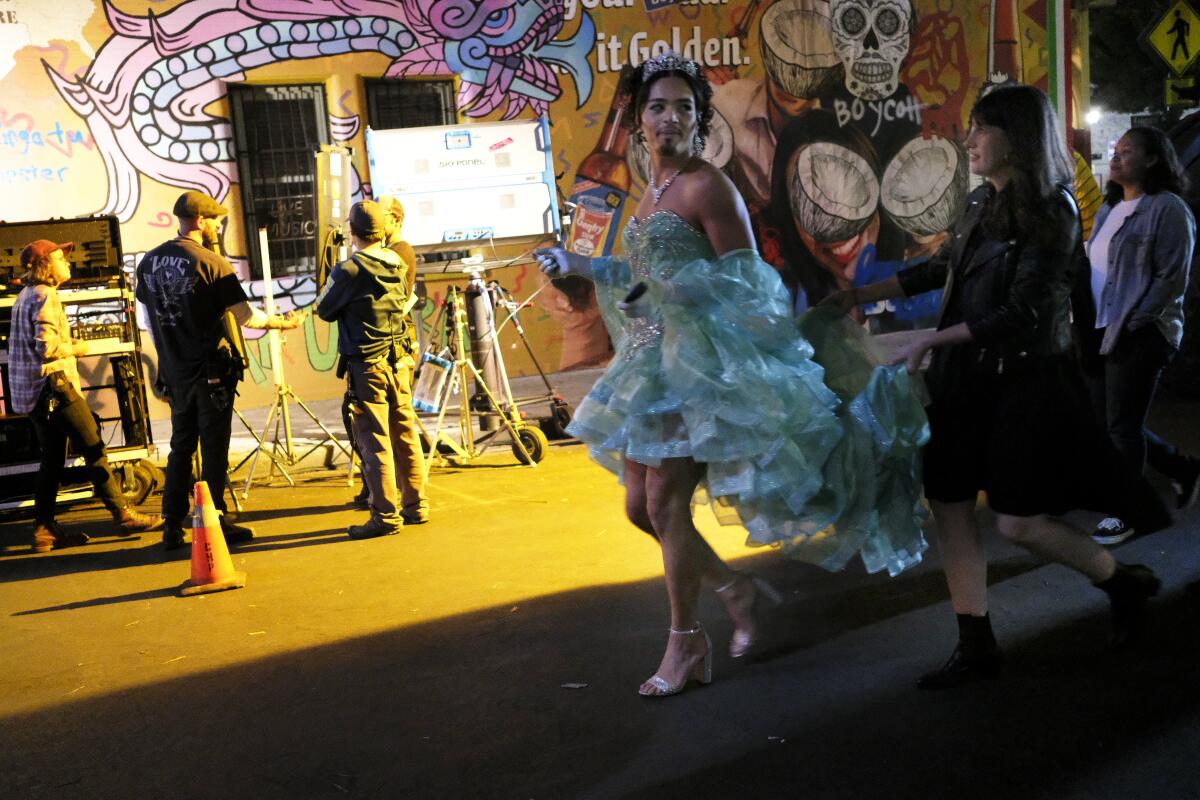How do you reinvent the quinceañera? Embrace the ’80s and make it queer

- Share via
Tonatiuh was 5 years old when he locked the door of his aunt’s room and tried on his first dress.
On a Thursday evening in November, Tonatiuh, who plays the queer, flamboyant and gender nonconforming Marcos Zamora in Starz’s “Vida,” was putting on another one. A much bigger, more special dress.
“That tightness is good,” Tonatiuh, 27, told costume designer Hannah Jacobs, who stood behind him adjusting the corset of the puffy, voluminous teal tulle dress.
“You can do tighter lower but not any higher,” he said, his hands pressed on his stomach, sucking in his belly.
He danced a quick run-through of the choreography he would perform on screen in a few hours: His silver high heels shuffled rhythmically to a song in his head. His arms sliced through the air. It felt just right. He could move and dance comfortably in the quinceañera dress.

In the third and final season of “Vida,” Lyn Hernandez (Melissa Barrera) throws her best friend Marcos an epic, ’80s-inspired, double “queerceañera”: a 30th birthday celebration, but queer and gender-bending.
“I always wanted Marcos to have a double quince” and put him in a big quinceañera dress, said “Vida” showrunner Tanya Saracho, who directed the “Queerceañera” episode.
In Mexican and other Latino cultures, the quinceanera is a celebration of a girl’s 15th birthday. It carries religious overtones and is considered a rite of passage that marks a girl’s transition from childhood to young womanhood. The celebration starts with a Mass and is followed by a party, where the quinceañera traditionally wears a tiara and wedding-gown-like dress. She has a father-daughter dance and is gifted a toy doll, a symbol of her last childhood gift.
Boys don’t get quinces or anything akin to them.

Saracho didn’t have one, either. Instead, she spent her 15th birthday in Europe, dancing the waltz in Vienna.
So when Saracho and the “Vida” team were brainstorming ideas for the quince’s aesthetic, she looked back to her adolescence. She found inspiration from “Quinceañera,” the groundbreaking 1987 Mexican telenovela she grew up watching in Mexico that starred a very young Thalía and Adela Noriega.
“There’s this imagery in the opening segment that is iconic,” said Saracho, describing the chambelánes in “fake soldier outfits” (Barrera wore a sexy one for her role as Marcos’ chambelána) and the scene featuring Thalía in a giant white dress, swaying back and forth on a swing.
Remembering that, she said to herself excitedly: “We have to go full on ‘Quinceañera’ from the ’80s,” complete with the telenovela melodrama, the swing, the music. “All of it. But queer.”
So they did.

When reenacting a quinceañera, the first order of business is the dress.
“For me, it all originated in a little boy’s fantasy and getting to bring that to life,” Jacobs said of the concept for the dress’ design.
She was thinking about what a young Marcos “wasn’t allowed to participate in” as a boy and wanted to “give him all of his hopes and dreams. To give him this fantasy.
“It was a big fairy tale moment for me,” she said. Chayanne’s “Tiempo de Vals,” a song often chosen for the quinceañera waltz, was also on her mind. She watched the music video dozens of times for inspiration.

Jacobs found the dress in downtown L.A.’s famed Santee Alley, the same flea market where teenage girls scout for their own giant, puffy dresses. Much of its skirt was recut and reworked, and some of the boning was removed so that Tonatiuh could move and dance freely.
Striking a balance between masculinity and femininity in the dress was tricky at first, but they soon realized they needn’t force it: Tonatiuh’s masculine body would take care of the former. “We really loved how the sweetheart neck of the dress was something so ultra femme, but against his pecs, shoulders, neck muscles and biceps, that was the moment that really melded those two worlds,” said Jacobs, as did the juxtaposition between his high heels and hairy legs.

Capturing the tradition of the quinceañera dress was as important as emphasizing its fun, sexy, modern twist. “Quinceañera dresses are iconic, and so I think there was an element of honoring that but also an element of who he is now and how he chooses to present himself and giving him that power,” Jacobs said.
After all, this wasn’t a typical celebration. As Jacobs said: This was “a ratchet party.”
But it’s more than that too. For Esti Giordani, the episode’s writer, the party is about visibility.
“Something so binary like, ‘You’re a woman now,’ there’s an inherent erasure” of queer, trans and gender nonconforming people in traditional celebrations like quinceañeras, she said. Instead, in true “Vida” fashion, the episode points the limelight on the LGBTQ community and allows Marcos to reclaim that rite of passage as a queer and non-binary person.
“I think the episode is so vibrant with that joyousness,” she said.

Back in November, Tonatiuh strutted onto the glittery pink set on a chilly L.A. night, his silver high heels clanking with every step on the pavement. Behind him, the train of his quinceañera dress extended like a wand.
“Heeey, la vida es desmadre!” he exclaimed to the cast and crew. “Life is a riot!”
Tonatiuh, who has Mexican and Nicaraguan heritage, is a self-described “femme-presenting male.” Growing up, he was sensitive and emotional and enjoyed playing with dolls. He often fantasized about having a quinceañera, just like his female cousins.
At age 13, he came out to his father. “He said, ‘OK. I love you and you’re still my son,’” he recalled. The following year, he told his mom. “I called her at work and I was like, ‘Mom, I have something to tell you.’” Her response was something like: “Oh. Do you want a cookie?”

“Queer Latinx culture is very unique,” he said. “Our desires, our wants, our fantasies are unique,” he said. “That’s what the show is about. It’s expressing something that hasn’t been expressed in a mainstream form. It’s allowing people to be witnessed.”
That visibility is one reason why Tonatiuh pursued acting: so he could spark change in the world.
“We have the ability to affect people in a really deep, powerful way,” he said. “That’s why I became a storyteller, to change the way that humanity thinks, and how we reflect and see ourselves, and how we can treat each other to create a more empathetic and tolerant society.
“And so if it means putting on a quinceañera dress and a tiara and shablaming on the screen,” he said, referring to a dance move, “so be it.”
More to Read
The complete guide to home viewing
Get Screen Gab for everything about the TV shows and streaming movies everyone’s talking about.
You may occasionally receive promotional content from the Los Angeles Times.







